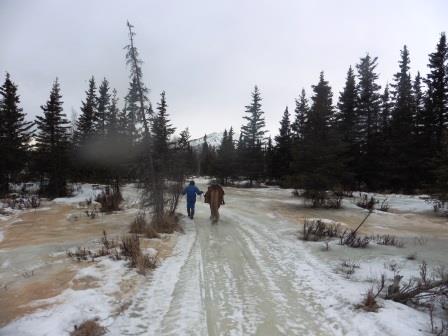
Home > Dispatches > Daily Dispatches 2016 >Daily Dispatch #45
February 14, 2016: Centered Trail Riding Instruction
Alaska winters are cold, and our unheated arenas even colder, so staying warm while instructing has required that I wear my Refrigerware suit, a wool hat, and gloves, and of course, warm boots. Admittedly, I’ve often wished that I was out on the trail, where because the sun shines brightly, there is the illusion of heat. At heart, I am a trail rider, and my Icelandic mare Raudhetta is a trail horse. Had she taken to arena work, I would have become a dressage rider. It was simply luck of the draw. We are now at the point in which she will draw upon her trail riding training, and jump low obstacles; however, I know that if I push it she’ll become uptight and resistant. Likes attract. The eleven or so individuals that I instruct on a once-a-week basis are primarily trail riders who last fall participated in their first Centered Riding clinic. They took to riding in the local Saddle Up arena during the darkest days of winter because this year there has been few other places to ride safely–this year the terrain in southcentral Alaska has mostly been icy. Being my friends, and being that they wanted Centered Riding instruction, I became their defacto teacher. |
|
|
I’ve attempted to instill the sense of fearlessness that’s needed when out in what one rider laughingly referred to as “the real world” in my reliance upon the use of obstacles. My collection of “fun stuff” includes but is not limited to tarps, poles, hula hoops, traffic cones, barrels, fun noodles, and a half dozen corn oil containers tied together with baling twine. The use of these obstacles goes hand-in-hand with the implementation of the six Centered Riding basics, a few examples of which follow. Alignment. It’s far easier to maintain and work on self-alignment in the arena than elsewhere. This is because the arena surface is flat; conversely, the trail surfaces are rolling and hilly. It’s for this reason, and because we have innumerable spruce trees in Alaska, that I use Sally Swift’s time-honored image of the spruce tree. I use the analogy of seeing ourselves trees and growing in both directions. Furthermore, I talk at length about being out on the trail and going up and down hills, and using the spindly trees as markers, thus enabling horses to move freely and balanced on the up and down slopes. Soft eyes. I impress upon students the importance of the use of peripheral vision and inner and internal and external awareness. To this end, we quasi arena users practice taking in what’s before us – usually numerous horses – and being proactive in determining where we might go next. I of course add that this is also essential when out on the trail, thus reducing the likelihood of accidents occurring. Breathing. My focus is on diaphragmatic breath, particularly in relation to raising and lowing the riders’ energy level and at the same time that of their horses. I’m convinced that there’s no better place than the arena setting for doing this sort of work, for out on the trail there are far more distractions. Centering. Here I go back to the use of image. I first have students place their hand on their abdomen, using the image of the sun, which I describe as being a warm ball of emanating light. I tell riders that focusing on this, the nerve center that controls the body movement, will serve them in good stead on the trail in maintaining mental and physical balance. In addition, bringing this image to mind comes in handy when one is tired, hungry, or lost – all things that can happen to one when out on our more circuitous and winding trails. Clear Intent. I preface talking about clear intent by telling students that even the best horses will balk or refuse to do things when out on the trail, using the example of the time that Raudi’s stablemate Mr. Siggi refused to cross a creek on the return trip home. I further suggest keeping in mind and implementing all the basics, and reiterate this by having students work on an exercise that involves the use of a teeter totter or bridge. I tell them to use the second person, including their horse in on their directive, which is to tell me in a loud voice exactly where they are going, as in “we are going in the direction of the far wall, and turning left, and stepping up onto and over the bridge.” The point that’s driven home is that good trail horses must cross bridges and the like, and clear intent on the rider’s part is paramount in taking charge and making sure this happens. Grounding. Last, but certainly not least, is this very important basic. I’ve memorized Sally Swift’s definition of the term, which is that “it is a feeling that your well-established center is dropping energy down through your legs and feet into the ground, while the energy of the ground comes up to your feet. . . you (then) know that nothing can knock you over.” In the arena, we thus practice WARM feet in the sand, this in preparation for those times on the trail in which we might be feeling on edge or insecure about unstable terrain. For me, I add that grounding works best when I’m crossing ice floes. Today, while teaching, I wore a light down jacket and a few less layers. And lo and behold, I did not see my breath when I issued riding-related directives. The sun and warmth have returned, and our biggest challenge as arena riders is now keeping our steeds from overheating. All, including myself, are looking forward to the first group trail ride, one in which we all put our Centered Riding training to practice. |
|

